The 14th US-China Green Energy Forum, jointly sponsored by the US-China Green Energy Council, the Chinese Society for Electrical Engineering, the Energy Internet Research Institute of Tsinghua University, and the Precourt Institute for Energy of Stanford University, was held both online and offline from December 2nd to 4th. The Forum was on the theme of "Opportunities and Challenges on the Path to Carbon Neutrality", and featured keynote speeches from Nobel laureates, academicians and researchers from China and abroad. Special sub-forums were held in Shanghai, China and San Francisco, USA. Experts and researchers in the energy and power sector exchanged insights and ideas on accelerating the development of a new energy system and advancing the clean and sustainable growth of energy and power to achieve carbon neutrality.
At the opening ceremony of the Forum on the morning of December 2nd, Eleni Kounalakis, Lieutenant Governor of California, and Jianmin Zhang, Consul General of the Chinese Consulate-General in San Francisco, extended their congratulations to the forum in letters. Mr. Chongqing Kang, Chair of the Department of Electrical Engineering and Applied Electronics and Director of the Energy Internet Research Institute of Tsinghua University, and Mr. Qi Wang, Chairman and CEO of the US-China Green Energy Council, both addressed the forum.
The forum featured keynote speeches from Steven Chu, Nobel Laureate, former US Energy Secretary and Chair of the American Association for the Advancement of Science and Professor at Stanford University, Yinbiao Shu, Academician of the Chinese Academy of Engineering, President of the Chinese Society for Electrical Engineering (CSEE) and the International Electrotechnical Commission (IEC), Yi Cui, winner of the Global Energy Prize 2021, Member of the National Academy of Sciences, and Director of the Precourt Institute for Energy of Stanford University, and Timur Gül, Head of the Energy Technology Policy Division at the International Energy Agency.
The forum was attended by Mingshan Lin, Deputy President of CSEE, Gang Wang, Secretary General of CSEE, Mary Nichols, former Chair of the California Air Resources Board (CARB) and Vice Chair of the California-China Climate Institute, and Robert Weisenmiller, former Chairman of the California Energy Commission. The forum was moderated by Weitai Guo, Board Member of the US-China Green Council.
Eleni Kounalakis, representing the Government of California, USA, extended her congratulations to the Forum. She remarked that California was a global leader in tackling climate change and had set ambitious targets for 100% clean energy power supply and carbon neutrality by 2045. The United States and China are collaborating on climate change and environmental protection in a positive and constructive manner, working together to accelerate the transition to a carbon-free future. She expressed her hope that this forum would play a role for all involved to discover innovative solutions to address climate change, enhance global cooperation, and to achieve the shared goal of sustainable development.
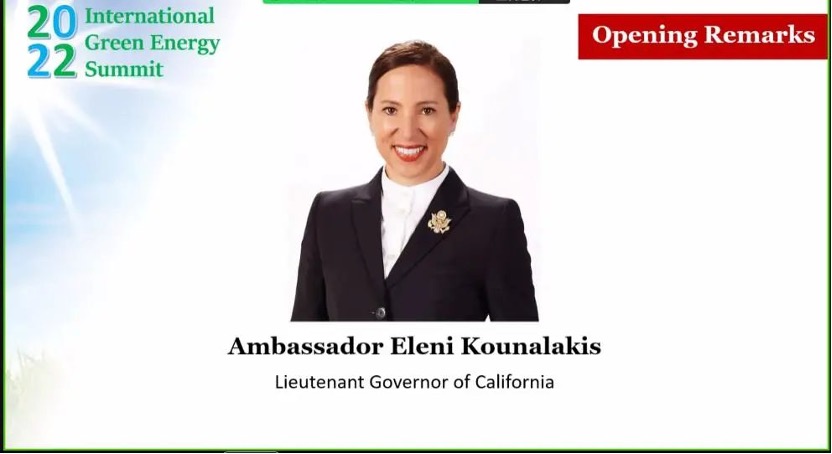
Eleni Kounalakis sending a letter of congratulations
Jianmin Zhang, representing the Chinese Consulate-General in San Francisco, expressed his warm congratulations on the opening of the Forum. He stated that China had adopted a national strategy to proactively tackle climate change, set the goals of “carbon peaking and carbon neutrality”, and steadfastly followed the path of ecological priority, green and low-carbon development. China and the United States have agreed on cooperation in tackling climate change. The US-China Green Energy Forum has developed into an important platform for dialogue and partnership in clean energy between the two countries. He wished that the Forum would contribute to the debate on the road to global carbon neutrality and play a constructive role in further advancing scientific and technological exchanges and local collaboration between China and the United States.
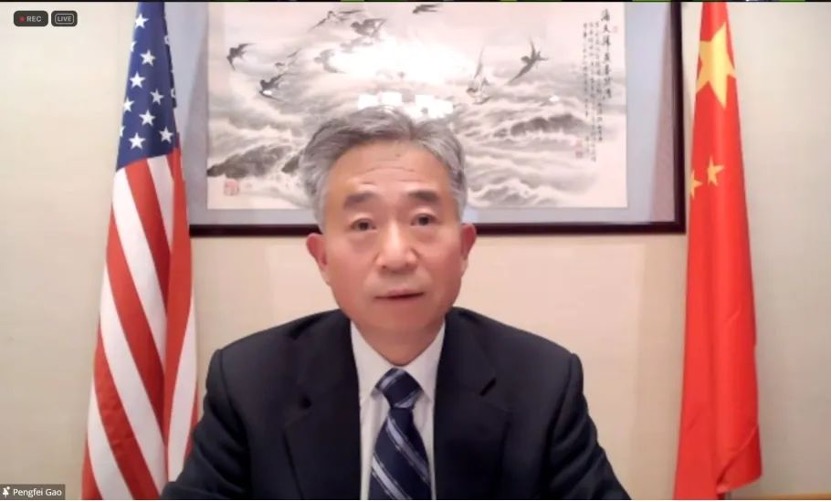
Pengfei Gao, Counselor for Scientific and Technological Affairs of the Chinese Consulate-General in San Francisco, reading a letter of congratulations
In his speech, Chongqing Kang emphasized that achieving carbon neutrality is a crucial objective for the world, and that this shared goal demands us to enhance cooperation in the energy sector. China has put forward major strategies such as the goals of “carbon peaking and carbon neutrality”, constructing a new power grid system, establishing a unified national power market, and developing a new energy system. The energy and power sector will undergo a disruptive institutional and technological revolution, and the low-carbon energy transition will be challenging and require a well-planned transition roadmap, with a special focus on the close ties between energy systems and the natural climate environment and benefiting all stakeholders through in-depth international cooperation.
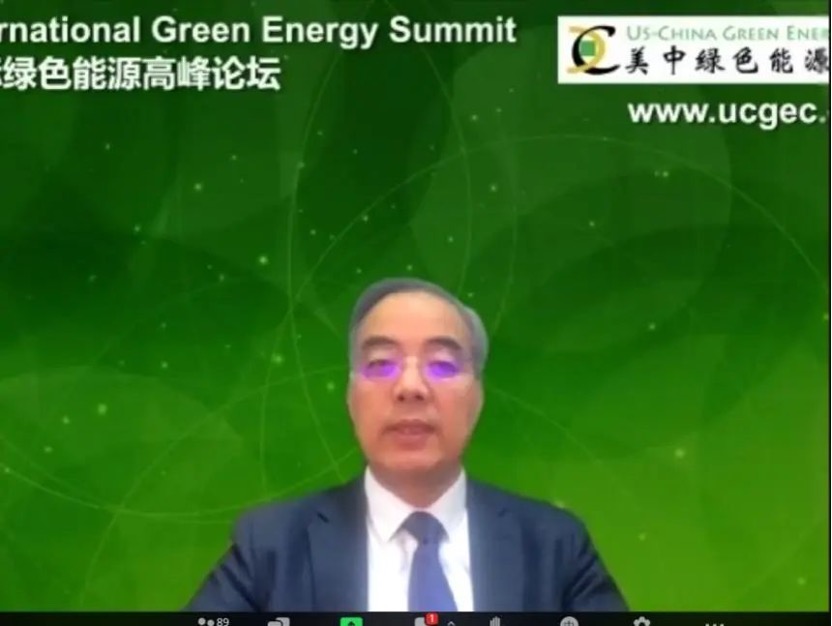
Chongqing Kang addressing the forum
In his speech, Qi Wang highlighted that the key to achieving carbon neutrality lies in “one core” and “two supports”, with the “one core” being technological innovation, which requires the creation of a low-carbon technology innovation system based on global cooperation, and the “two supports” referring to policy support and investment support. It is essential to create a sound policy system to facilitate the attainment of carbon neutrality goals, and to set up global and regional carbon trading markets to offer necessary financing tools for cutting carbon emissions. Global cooperation is crucial to reach carbon neutrality, and researchers, experts, and engineers from China and the United States are urged to participate in multi-level exchanges and cooperation in “net zero” technologies with common interests.
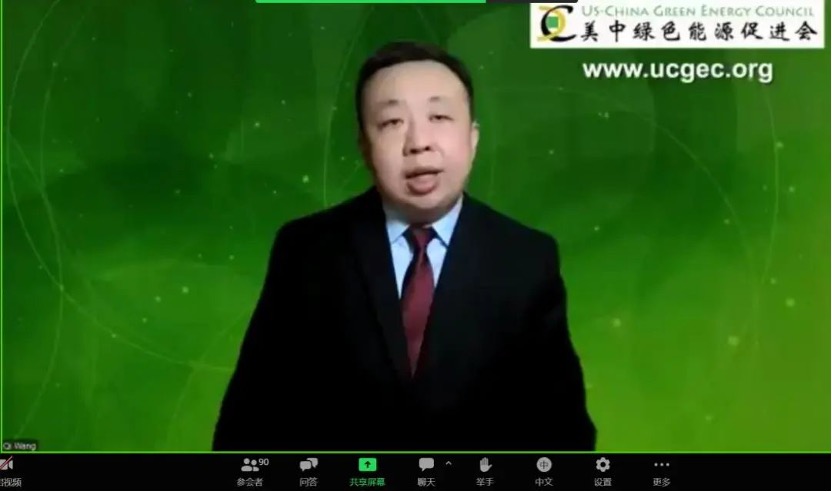
Qi Wang delivering a speech
In his speech titled Challenges and Opportunities in the Transition to Clean Energy and a More Sustainable Future, Steven Chu emphasized that we must achieve zero or negative emissions to prevent the global average temperature from rising by more than 2°C above the benchmark. He claimed that there was a substantial gap between the current emission reduction actions and this target, and that more efforts would be needed. A more advanced and stable power grid is necessary to support renewable energy, and greenhouse gas emissions from all sectors should be cut. A higher share of renewable energy requires more effective and affordable storage. Rational management should be implemented on the demand side, and a fourth agricultural revolution is essential to lower greenhouse gas emissions from farming. The ultimate goal of our endeavors to tackle climate change is to achieve wider and longer-lasting security for our families, friends, neighbors, our countries, and future generations.

Steven Chu delivering a keynote speech
In his speech on Green and Low-carbon Transformation and Innovative Development of China’s Electric Power, Dr. Yinbiao Shu emphasized that China’s green low-carbon transformation of electric power had achieved remarkable results. The energy supply capacity has been greatly enhanced and the world’s largest clean energy supply system has been established in China with excellent energy conservation and carbon reduction outcomes, and China’s low-carbon technology industry has grown rapidly. He suggested the transformation path of China’s energy and power under the goals of “carbon peaking and carbon neutrality”. It is essential to adhere to the “carbon peaking and carbon neutrality” goals, enable the transformation of energy and power to deep low-carbon (zero carbon), implement the transformation path of cleanliness, electrification, digitalization and standardization, construct a low-carbon (zero carbon) power grid system of depth and breadth in three stages: carbon peaking, deep low-carbon and carbon neutrality by accelerating the development of onshore wind power, offshore wind power, Southwest hydropower and nuclear power, advancing the development and utilization of biomass, geothermal energy and green hydrogen, and building a clean energy supply system with multiple complementary energies. He urged to actively conduct research and development of key technologies for deep low-carbon (zero carbon) power grid systems, including clean power generation, energy storage, hydrogen energy, re-electrification, carbon capture and sequestration, digitalization, secure and stable control of large power grids, development of technical standards, and creation of power markets, so as to foster breakthroughs in core technologies and provide technologies to facilitate global green and low-carbon transformation, and make greater contributions to building a community of shared future in which the human society and nature would coexist in harmony.
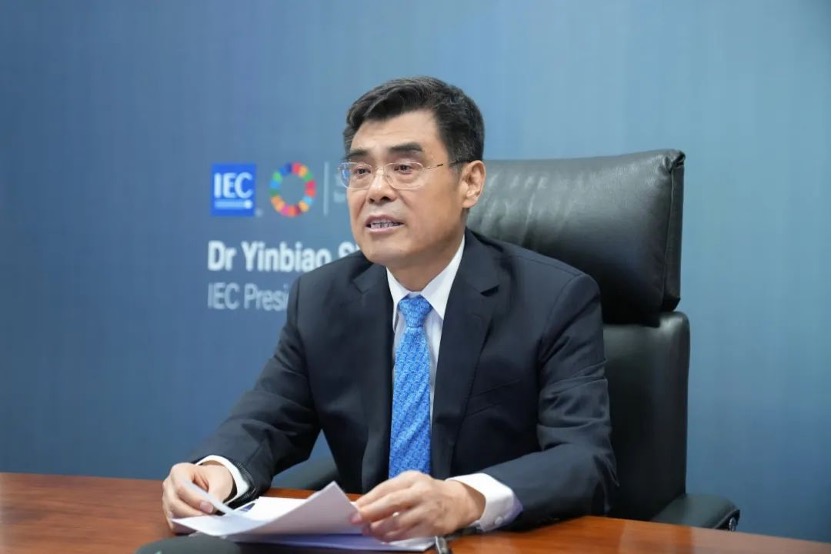
Dr. Yinbiao Shu delivering a keynote speech
In his speech on Materials Technology for Transition to Carbon Neutrality, Yi Cui emphasized that many countries have pledged to achieve "net zero" emissions by 2050, 2060, and 2070, which requires the collaboration of enterprises, governments, and academics. He also referred to the top 10 clean energy technologies, such as long-term energy storage, low-cost batteries with high energy density, carbon capture and decarbonization, renewable fuels, digitization and integration of energy systems, recycling of low-carbon iron, low-carbon cement, and plastics, sustainable food, and nuclear energy. Stanford's vision for energy is to provide technology for sustainable, affordable, and secure energy supplies. The global transition to carbon neutrality requires simultaneous decarbonization in various industries, and materials technology may play a significant role in this process. He expressed his hope that the platform for US-China cooperation could be leveraged to further promote the implementation of some new projects and contribute to sustainable development.
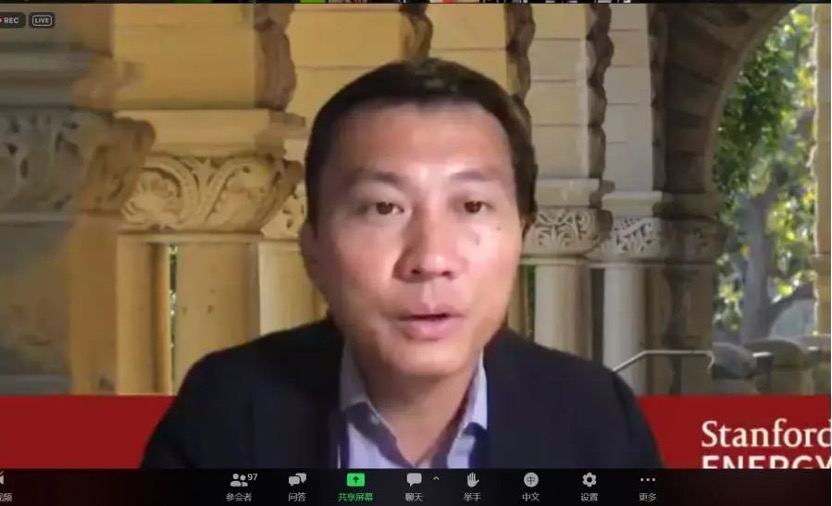
Yi Cui delivering a keynote speech
In his speech on IEA’s Roadmap for 'Net Zero' Emissions by 2050, Timur Gül explained that the Roadmap aims to provide guidance for all countries on how to achieve 'net zero' emissions by 2050 while ensuring safe, sustainable and affordable renewable energy. To achieve this goal, 50% of the emission reduction should be driven by technological innovations such as electrification, hydrogen energy, carbon capture and biotechnology. China has set 30 and 60 targets to achieve a 40% CO2 reduction, which requires cutting-edge technologies. China has emerged as a global leader in clean energy innovation, accounting for 10% of the world's investment in renewable energy. Both China and the United States are crucial for the clean energy transition and should cooperate on innovative technologies under the framework of the International Energy Agency. He stressed that their analysis indicated that without international cooperation, the global transition to zero emissions would be postponed by decades, so it is imperative to exchange experiences and seek common solutions.

Timur Gül delivering a keynote speech
The Forum hosted a dialogue on "The Path to Carbon Neutrality" with Robert Weisenmiller, former Chairman of the California Energy Commission, as the moderator. In this dialogue, Mary Nichols, former Chair of the California Air Resources Board and Vice Chair of the California-China Climate Institute engaged with participants about key issues on carbon neutrality. They discussed topics such as California's greenhouse gas reduction plan, the challenges for the California Air Resources Board, cooperation between California and China on climate, and the challenges of achieving carbon neutrality.

Dialogue on "The Path to Carbon Neutrality"
On the mornings of December 3rd and 4th, the "Sub-forum on Energy Storage Technology" and the "Sub-forum on Transition to Clean Energy" took place in Shanghai and Stanford University respectively.
On the morning of December 3rd, the “Sub-forum on Energy Storage Technology” was held in Shanghai. The forum featured speeches from Stanley Whittingham, 2019 Nobel Prize winner, member of the American Academy of Engineering, and Distinguished Professor of the State University of New York, Guanhua Chen, professor of the University of Hong Kong, Yang Pang, Vice Chairman of CUSPEA and Director of Carbon Neutrality Research Institute of China Chief Economist Forum, and Xiao Yan, Founder and Chief Scientist of MS Energy and Director of Shanghai Volta Energy Storage Digital Research Institute.
On the morning of December 4th, the "Sub-forum on Transition to Clean Energy" took place. This sub-forum featured a speech from Steven Chu, and also included speeches from Robert Weisenmiller, former Chairman of the California Energy Commission, Xiaoxin Zhou, Academician of the Chinese Academy of Sciences, international member of the NAE, and Honorary President of China Electric Power Research Institute, and Larry Goulder, Director of the Stanford Environmental and Energy Policy Analysis Center.
The Forum also showcased 3 research results, namely, "The Energy Technology Innovation on the Path towards Carbon Neutrality", "Accelerating the Process of Decarbonization between China and the United States and Promoting Bilateral Cooperation on Climate Change", and "Achieving 80% zero-carbon Electricity System in China by 2035".